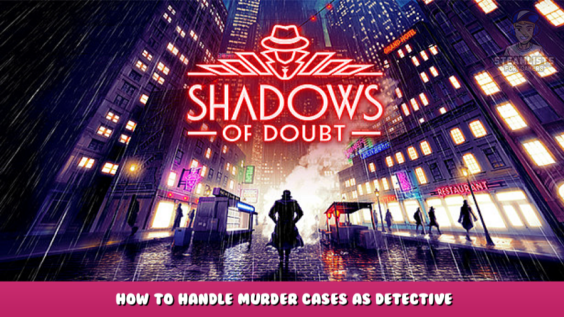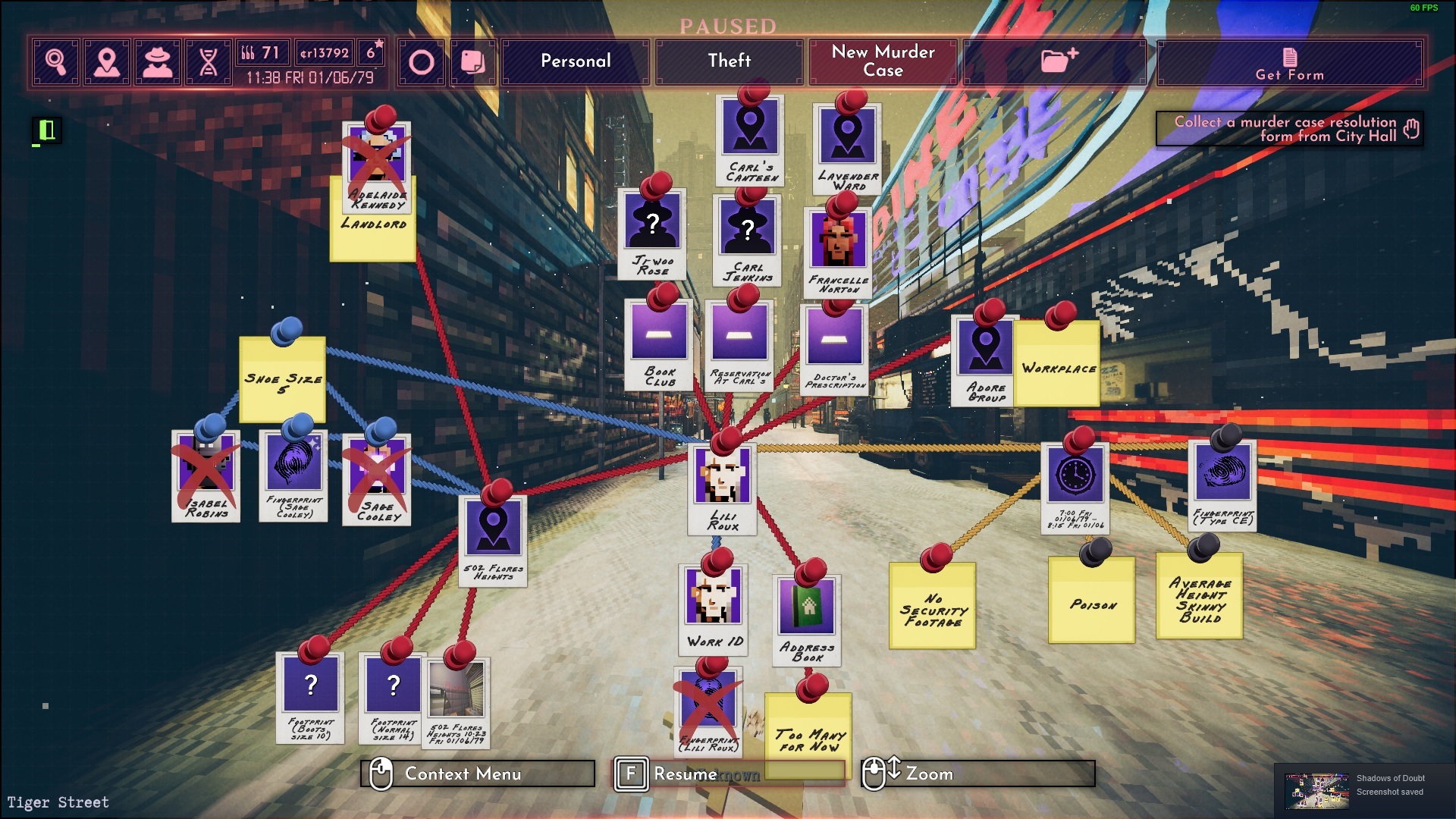
Hey there, welcome to this post, This post will provide you with information regarding the Shadows of Doubt – How to handle murder cases as Detective, and we hope you will find this material helpful.
This guide explains how to solve murder cases. It explains what to look at, the workflow, and tricks for a successful investigation.
Rushing to a scene
You will be notified quickly if a new case of murder is reported.
If you can, get to the accident scene as soon as possible.
The murderer is often close by.
At least, inspect and pin every person entering and leaving your building.
Asking 1 to 3 other people if anything is suspicious will often lead to a description of the person next to them.
Investigating a Crime Scene
Here you will be looking for 10 items. You’ll be pinning them in mass. The board should have everything except duplicates. You want your board to be as thorough as possible.
a. The Victim
- Determine who the victim is.
- Take his fingerprints.
- Take his boot (Pin) size
- The time of death, and the type(s) of murder weapon.
- Building he’s In (Pin this.)
b. Fingerprints
Prints from the victim and (optionally) her spouse will be found scattered around the apartment. They may touch the safe, the door, or the light.
In corporate environments, there could be more. In that case you’ll be required to eliminate every coworker. In this case you can use the employee database to print out every employee.
[As much as I know, a murderer must leave at minimum 1 print] They can also be in hard to find places. On top of curtains or drawers, for example.
c. Footprints
There will also be footprints of the perpetrator, victim, murderer and (optionally) spouse. Pin them.
The Murder Weapon
Often, a murder weapon is found at a crime scene. It could loosely be on the floor, in a cabinet, out in the open, or behind a blanket. You will want to search for any type weapon that matches a murder weapon. Scan them for prints. Once you have found it, pin it.
You can also perform this action from the Inventory screen.
[Note to devs: Even without prints, it should be possible match an instrument to a crime. It’s currently not.
Address Book
Every household possesses an address book. Check it. This is gold. Pin it.
f. Places of Employment
You will find the victim’s place of work by looking in their closet for a worker ID card, wallet, or employment contract. Pin the work place.
g. E-Mail
The victim may have received mail that contains clues about the murderer. If you see something suspicious, print it. You should also print any clubs the suspects frequent. All the information must be pinned.
Last Call
If there is a call, go to the phone and note it. You can find out from which building a call came by looking at the telephone in the basement.
i. Notes and envelopes
Notes reveal if a victim was doing other things. For example, shopping at one place and making an appointment elsewhere. These things are also important to pin. Also, the victim’s landlord’s contract should be pinned.
Graffiti
Occasionally a murderer might leave writings on a wall. Photograph it. Photograph it
Example: Finished Crime Scene
In this particular case, I managed by asking witnesses outside the house for hints before entering.
After a thorough inspection of the victim’s house, I found a lot of leads.
This case is made more complex by the lack of security footage, which was not taken in the apartment.
Checking Security Footage
Security footage lasts for 24 hours. The footage will disappear if you’re not quick enough.
Every building must have a secure room. I’ve come across some bugged rooms. [But it can spawn randomly in the most bizarre places. In apartment building, they may spawn on a completely random floor. There’s no way around checking every door and running down each stairway. You will find a camera icon in the security room and it will be marked on a map.
To the estimated time of death add an extra hour at both ends and check the video. You should print out photos, magazines and other pieces in bulk and pin them up on your board.
Once you have covered the timeframe you can click on the pictures, click on the connections and then add the potential suspects in the photographs to your board.
Questioning Witnesses
It’s now time to knock the doors of neighbours on the same or lower floor, and random passersby if you have seen anything suspicious. Idealy, the neighbors will know and provide clues like the victim’s body build. Note it down in your caseboard.
You can also identify suspects by looking at photographs. That’s why you pin the suspects that are on the security footage. You can always ask them questions and sometimes, they will give the name of an individual suspect.
People usually know their neighbours. If somebody stands out for not being known by anyone, he becomes prime suspect. They aren’t neighbors, or they don’t usually show here.
Board Work
You should at this point have all of the materials you need to conduct an effective investigation. It is time to go back to the caseboard to draw some outlines and collect the information that you have. Prints of the suspect, boot size and details from witnesses. Calls, notes or photographs. You’ll have plenty of material to work with.
Also, click the address book button and pin all your friends. They’re suspects.
It is time to eliminate the suspects. Cross-reference all the information you have on the murderer. Remove old suspects from the list by right clicking their pin.
You’ll be in a position to eliminate a lot of people and still have tons of threads open to work through. Normally, only a few suspects will remain.
Tie Up Loose Edges
If you have solid leads, you can focus on closing them.
a. Neighbors
It’s easy to exclude fingerprints. Simply scan their doorhandles at the front doors. You can then rule out a building.
[To do] Can you check the fingerprints on residents in the security area? Double check]
b. Co-Workers
Go to their workplace. You can either break in with a key or purchase a guest pass. Enter the employee data base. Get information on every single employee. You will know their names, and you’ll also have their prints. You can eliminate a great deal of people with this method.
Friends
Pin all the friends in the victim’s addressbook
Last Caller
If the victim made a call, you will know which building they came from. Go to that building, open the telephone and see what apartment it was. Investigate this caller to eliminate it.
e. Club Members
People can join a club and meet every now and again in a pub or restaurant. Typically, they’re advertised by newspapers and in some restaurants. Emails about these events are also available on restaurant computers.
[To Do: Learn more. Currently it’s really rare and extremely hard to find this.
Businesses
The victim most likely had receipts laying around from places that they have visited. Restaurants, bars, clincs. It is time to raid them. Get the employee records, and eliminate suspects from these places.
The world is your oyster
This is the place no one wants to be. When every good leader is a failure, you can’t exclude anyone, or you have to leave everyone out.
It’s now time to visit the government database, located on the third level of city hall. If you have access to a PC, just enter the name of your suspect and you’ll be able to get almost all his information. This is borderline theft, and it works exceptionally well.
You will either miss something very important or the case can be extremely hard. Either statement can be accurate. Re-check your work.
If that fails too, there’s only one thing to do:
Sit down and wait.
The murderer strikes again
“I wish i had known.”
a. Security rooms are spawned on random floors, or do not spawn. [Dev: Is that intentional?]
b. The homeless refers to other homeless individuals as if they were ‘living together’, which is confusing.
The street vendor’s workplace is set to the house they live in. This doesn’t make any sense.
This concludes the guide! This guide is updated and will be filled out in more detail in the future.
Share your comments on our most recent post, Shadows of Doubt – How to handle murder cases as Detective, and let us know if there’s anything we can do to improve it or if you notice an error. We’ll make the required modifications as soon as we can. We appreciate you so much and wish you a wonderful rest of the day. Creator and writer Darian was the inspiration for this article. Also, if you like the post, don’t forget to add us to your bookmarks; we publish new posts every day with additional material, so be sure to check back with us frequently for more posts.
- All Shadows of Doubt Posts List



Leave a Reply